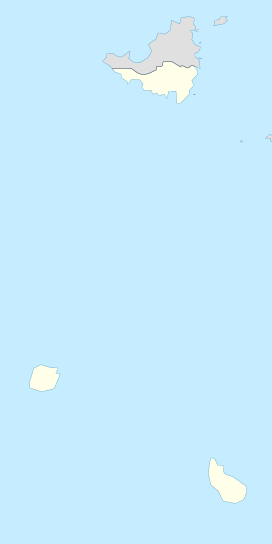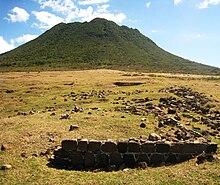This is the current revision of this page, as edited by IvanScrooge98 (talk | contribs) at 21:37, 27 September 2024. The present address (URL) is a permanent link to this version.
Revision as of 21:37, 27 September 2024 by IvanScrooge98 (talk | contribs)(diff) ← Previous revision | Latest revision (diff) | Newer revision → (diff) Stratovolcano on the island of Sint Eustatius| The Quill | |
|---|---|
 Looking southeast across Statia toward the Quill Looking southeast across Statia toward the Quill | |
| Highest point | |
| Elevation | 601 m (1,972 ft) |
| Prominence | 601 m (1,972 ft) |
| Listing | Volcanoes in the Netherlands |
| Coordinates | 17°28′40″N 62°57′35″W / 17.47778°N 62.95972°W / 17.47778; -62.95972 |
| Geography | |
  | |
| Geology | |
| Mountain type | Stratovolcano |
| Volcanic arc | Lesser Antilles Volcanic Arc |
| Last eruption | 250 CE ± 150 years |
The Quill (/kwɪl/ KWIL), also known as Mount Mazinga, is a stratovolcano located on the island of Sint Eustatius in the Caribbean Netherlands. The summit elevation of 601 m (1,972 ft) above sea level makes it the second highest mountain in the Netherlands.
The name Quill originates from the Dutch term kuil (pronounced [kœyl] ), meaning 'pit' or 'hole', which was used originally with reference to the volcanic crater. The Quill was designated as a national park by the government of the Netherlands Antilles in 1998. Quill/Boven National Park is administered by the Sint Eustatius National Parks Foundation, STENAPA, which maintains a number of trails for hikers.
The Quill formed between 22,000 and 32,000 years ago to the southeast of Sint Eustatius (Statia) in the West Indies. Pyroclastic flows during the initial eruption joined The Quill with what is now the rest of Sint Eustatius. The last known eruption, as determined by radiocarbon dating, occurred about 1,600 years ago. The volcano had a VEI of 4 in the eruption.
Flora and fauna

The crater of The Quill contains a lush rainforest populated by native and introduced tropical trees and plants. These include elephant ears, tree ferns, begonias, figs, plantains, bananas, bromeliads, trumpet wood, mahogany, seedless breadfruit, Surinam cherry, ginger bush and edible raspberries, as well as at least 17 different kinds of orchids. Resident animal species include iguanas, anoles, snakes, Caribbean hermit crabs, butterflies, exotic birds, and occasional goats and chickens that have strayed from nearby Oranjestad.
References
- ^ "The Quill". Global Volcanism Program. Smithsonian Institution. Retrieved 6 August 2013.
- "Topographic map of The Quill". opentopomap.org. Retrieved 27 April 2023.
- "Global Volcanism Program | The Quill". Smithsonian Institution | Global Volcanism Program. Retrieved 2024-09-18.
| Highest points of North America | |
|---|---|
| Sovereign states | |
| Dependencies and other territories | |